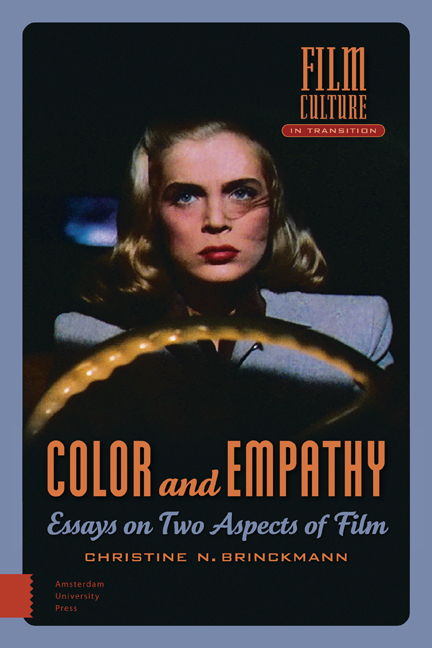Book contents
- Frontmatter
- Contents
- Preface
- Dedication
- Cinematic Color as Likeness and as Artifact: [2001]
- Chords of Color: [2006]
- The Tension of Colors in Colorized Silent Films: [2001]
- Structural Film, Structuring Color: Jenny Okun's Still Life: [1995]
- Desert Fury: A Film Noir in Color: [2012]
- The Work of the Camera: BEAU TRAVAIL: [2005]
- Empathy with the Animal: [1997]
- Motor Mimicry in Hitchcock: [1999]
- Abstraction and Empathy in the Early German Avant-garde: [1997]
- The Role of Empathy in Documentary Film: A Case Study: [2005]
- Genre Conflict in Tracey Emin’s Top Spot: [2007]
- Viewer Empathy and Mosaic Structure in Frederick Wiseman’s PRIMATE: [2009]
- CASTA DIVA: An Empathetic Reading: [2008]
- Publication Data
- Index of Films
- Index of Subjects
- Film Culture in Transition
Structural Film, Structuring Color: Jenny Okun's Still Life: [1995]
Published online by Cambridge University Press: 23 June 2021
- Frontmatter
- Contents
- Preface
- Dedication
- Cinematic Color as Likeness and as Artifact: [2001]
- Chords of Color: [2006]
- The Tension of Colors in Colorized Silent Films: [2001]
- Structural Film, Structuring Color: Jenny Okun's Still Life: [1995]
- Desert Fury: A Film Noir in Color: [2012]
- The Work of the Camera: BEAU TRAVAIL: [2005]
- Empathy with the Animal: [1997]
- Motor Mimicry in Hitchcock: [1999]
- Abstraction and Empathy in the Early German Avant-garde: [1997]
- The Role of Empathy in Documentary Film: A Case Study: [2005]
- Genre Conflict in Tracey Emin’s Top Spot: [2007]
- Viewer Empathy and Mosaic Structure in Frederick Wiseman’s PRIMATE: [2009]
- CASTA DIVA: An Empathetic Reading: [2008]
- Publication Data
- Index of Films
- Index of Subjects
- Film Culture in Transition
Summary
The designs and aesthetic principles of Structural Film already seem part of the past, although this current of the avant-garde was very much alive into the 1980s. What is more, experimental film assisted the “other cinema” in gaining a moment of cultural recognition of a magnitude it has rarely enjoyed in its turbulent history.
It is characteristic of experimental film that its variants are heterogeneous, displaying only distant commonalities. The films can sketch out dream visions, provide a contemplative look at a landscape, offer variations on visual themes (the view out a window, the movement of water), toy with remembrance and autobiography, compile found footage, upend narrative structures, associate streams of consciousness, or alienate the illusionist character of photography – to name but a few approaches. Even within these differing categories, the films adopt formal languages of their own and are difficult to classify. Structural Film, by contrast, seems to be unified by a cogent program.
Structural Film began to challenge the dominance of the New American Cinema and the Underground Film in the late 1960s. It arose in a climate that had become characterized by a subjective, sometimes lyrical, sometimes consciously anarchistic style – Stan Brakhage, Carolee Schneemann, Jonas Mekas, Kenneth Anger, and Jack Smith come to mind. For all of them, personality was at the fore, whether through the experiential self, as subject or object of subcultural art, or through extravagance, sexuality, and other heightened personal experiences. In each instance, the photography and editing reflect an individual, spontaneous style. Sensation, atmosphere, empathy, improvisation, performance, radical gestures, vitality, and sensuality were more crucial than polished precision, conceptuality, self-reflection, consolidation, or formalism. In contrast, Structural Film would mainly pursue the second list of characteristics, signaling a shift of style. Moreover Structural Film's clear affiliation with the concerns of contemporary visual art, and Minimalism in particular, also marked a major change of direction.
Structural Film follows a conceptual program explorative of its premises. The works revolve around the characteristics of the medium, whether to make a certain parameter visible or to run through variations of it. Stasis (1976), for instance, from the Californian filmmaker David Wilson, set up a relationship between zoom and camera movement used simultaneously and in opposition to explore their effects.
- Type
- Chapter
- Information
- Color and EmpathyEssays on Two Aspects of Film, pp. 75 - 88Publisher: Amsterdam University PressPrint publication year: 2014



